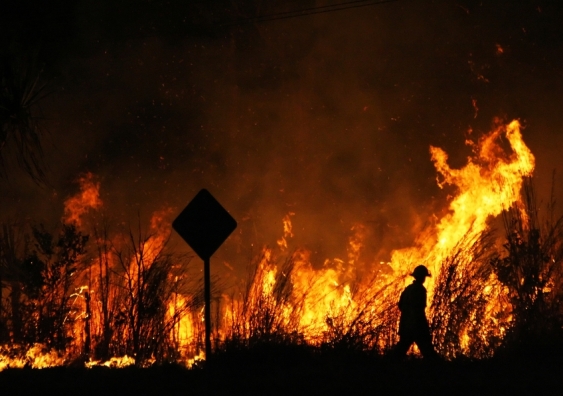BMP Essentials: Protecting Your Home Versus Bushfire Risks
BMP Essentials: Protecting Your Home Versus Bushfire Risks
Blog Article
Crucial Tips for Bushfire Monitoring to Guarantee Fire Security

Understanding Bushfire Danger Degrees
Understanding the differing levels of bushfire danger is important for effective preparation and preparation in mitigating possible risks to lives and buildings. Bushfire danger levels are usually classified based upon aspects such as weather, fuel schedule, topography, and historic fire habits. By understanding these risk areas, levels and people can proactively apply methods to lower vulnerability and enhance strength when faced with possible bushfire occasions.
The initial degree of bushfire danger is low threat, where the chance of a bushfire occurring and triggering substantial damage is very little. High-risk degrees indicate a significant danger, with conditions conducive to rapid fire spread and severe fire habits.
Understanding these bushfire threat levels enables stakeholders to tailor their readiness and action activities accordingly, guaranteeing a efficient and proactive method to bushfire management.
Establishing a Defensible Area
Effective bushfire management starts with establishing a defensible space around residential or commercial properties to boost protection against potential fire risks. A defensible space is a buffer area that produces an obstacle in between a structure and the bordering flammable vegetation. This space serves as an important line of defense, giving firemans a risk-free location to operate and aiding to minimize the risk of a fire infecting the property.
When establishing a defensible space, it is important to consider the format of the property and the bordering landscape. Cleaning plant life, specifically very flammable plants, within a certain distance of the residential or commercial property can help prevent the fast spread of fires. Additionally, keeping a well-irrigated area around the residential or commercial property can even more improve its defensibility.
Normal upkeep of the defensible area is essential to guarantee its efficiency. This consists of cutting overhanging branches, getting rid of dead plant life, and keeping the area without particles. By spending effort and time right into creating and keeping a defensible area, property owners can substantially boost their opportunities of shielding their homes and assets during a bushfire.
Executing Fireproof Landscaping
When designing landscapes to minimize the risk of bushfires, including fire-resistant components is necessary for boosting property security and minimizing fire hazards. Select plants with high moisture web content, reduced oil web content, and very little dead plants to lower the risk of fire spread.

Producing an Emergency Situation Discharge Plan
Creating a detailed emergency situation emptying strategy is important for guaranteeing the security and health of individuals throughout potential bushfire occurrences (BAL Assessment). A reliable emptying plan should detail clear procedures to comply with in case of a bushfire risk, consisting of marked emptying routes, assembly points, and communication procedures
To begin developing an emergency discharge plan, it is important to assess the details dangers and susceptabilities of your location. Identify several evacuation courses that result in secure areas far from the fire, thinking about elements such as surface, road access, and prospective dangers. Develop communication networks to sharp homeowners of an approaching discharge, utilizing techniques such as alarms, text signals, or door-to-door alerts.
On a regular basis review and exercise the evacuation strategy with all citizens or community participants to guarantee everybody recognizes their obligations and duties. Conduct drills to test the effectiveness of the strategy and make any kind of needed modifications. By having a well-prepared emptying plan in location, you can enhance the possibilities of a risk-free and organized discharge during a bushfire emergency situation.
Keeping Fire Safety And Security Devices
After establishing an extensive emergency discharge prepare for bushfire cases, it is vital to prioritize the regular upkeep of fire security devices to make sure optimum capability and preparedness. Normal upkeep of fire safety and security tools such as fire extinguishers, smoke alarm, fire alarms, and automatic sprinkler is essential in safeguarding lives and residential property during a bushfire. Conducting regular assessments, screening, and servicing of these tools by qualified professionals is important to guarantee they are in working order when required.
Fire extinguishers should be examined regularly for pressure levels, visible damage, and correct performance. Smoke alarm must have their batteries replaced a minimum of annually and go through month-to-month testing to guarantee they are operational. Smoke alarm and automatic sprinkler must be examined regularly to validate they are linked and functioning properly. In addition, it is essential to maintain fire safety and security equipment obtainable, unobstructed, and plainly classified for easy identification throughout an emergency. By vigilantly keeping fire security equipment, people can improve their readiness and feedback capabilities in case of a bushfire.
Verdict
In final thought, effective bushfire administration involves comprehending threat degrees, developing defensible spaces, applying fireproof landscaping, creating evacuation strategies, and maintaining fire safety more info here and security equipment. By complying with these vital ideas, individuals can ensure far better fire security and safety for their communities and homes. It is necessary to focus on aggressive actions to mitigate the dangers connected with bushfires and to be prepared for emergency situations.
By recognizing the subtleties of bushfire risk levels, developing defensible rooms, implementing fireproof landscaping, developing extensive discharge plans, and making certain the upkeep of fire safety and security equipment, communities and individuals can significantly bolster hop over to these guys their strength versus the ravages of wildfires - BAL Assessment. These suggestions are not only important for guarding versus prompt fire risks however likewise for promoting lasting fire protection methods that can make a considerable difference in the face of escalating bushfire hazards
High-risk levels indicate a considerable risk, with conditions conducive to quick fire spread and severe fire actions. Regular upkeep of fire security devices such as fire extinguishers, smoke detectors, fire alarms, and sprinkler systems is essential in safeguarding lives and property during a bushfire.In conclusion, efficient bushfire monitoring includes recognizing risk levels, developing defensible spaces, executing fireproof landscape design, developing evacuation strategies, and maintaining fire safety equipment.
Report this page